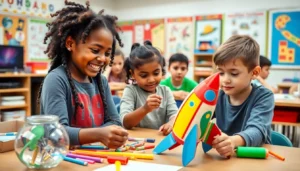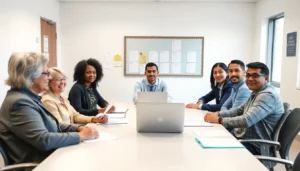Table of Contents
ToggleIn a world where traditional classrooms sometimes feel like a never-ending episode of a boring sitcom, alternative education programs offer a refreshing twist. They provide unique learning experiences that cater to diverse needs, ensuring students don’t just survive but thrive. Imagine a place where creativity and curiosity reign supreme, and the only tests involve your ability to think outside the box.
Understanding Alternative Education Programs
Alternative education programs provide distinct learning opportunities outside traditional classrooms. These programs cater to various learning styles, promoting innovative education methods that engage students effectively.
Definition and Purpose
Alternative education programs encompass various educational approaches that prioritize individual student needs. They aim to create flexible learning environments that empower students, fostering personal growth, critical thinking, and self-directed learning. Such programs often benefit at-risk students and those seeking non-conventional education methods. They support diverse educational goals, emphasizing holistic development, social skills, and academic success.
Types of Alternative Education Programs
Different types of alternative education programs cater to unique student populations. Schools may include Montessori, Waldorf, or homeschooling methods. Each approach encourages self-paced learning and creativity. Online learning platforms offer virtual flexibility for remote education. Charter schools provide innovative curricula, often with specialized programs like arts or sciences. Finally, experiential learning programs focus on hands-on activities, reinforcing skills through real-world applications. These diverse options tailors education to better suit the needs of various learners.
Benefits of Alternative Education Programs
Alternative education programs offer distinct advantages that enhance the learning experience. These programs adapt to individual student needs, fostering engagement and personal growth.
Personalized Learning Experience
Personalized learning experiences define alternative education programs. Students often receive tailored instruction that addresses specific learning styles. Unique curricula encourage exploration, allowing for deeper understanding and retention of knowledge. Students engage with material that resonates with their interests, increasing motivation. Teachers frequently provide one-on-one support, helping students navigate challenges effectively. This customized approach cultivates self-directed learning and critical thinking skills.
Flexible Learning Environments
Flexible learning environments significantly contribute to student success. Many alternative education programs prioritize adaptability, allowing for adjustments based on student progress. Learning can occur in various settings, whether inside traditional classrooms, outside in nature, or through online platforms. This versatility accommodates different schedules and lifestyles, supporting diverse learning preferences. Students often find themselves in inclusive settings that foster collaboration and communication, enhancing the overall educational experience. Engaging in hands-on activities encourages real-world connections and practical skill development.
Finding Alternative Education Programs Near Me
Searching for alternative education programs involves utilizing various online and community resources. These tools simplify the process and connect students to suitable options.
Online Resources and Directories
Numerous websites offer comprehensive directories of alternative education programs. Platforms like GreatSchools and Niche provide detailed listings, including user reviews and ratings. These platforms allow filtering by location, program type, and student needs. Search engines also yield valuable results when using specific queries, such as “alternative education programs near [your location].” Educational blogs and local forums often share insights about unique programs. Engaging in social media groups focused on education can lead to recommendations from other parents or educators.
Local Community Resources
Libraries and community centers frequently serve as hubs for alternative education resources. These venues may host workshops, informational sessions, and connections to local programs. Local school districts often provide details on charter schools and other alternative options available in the area. Networking with educational professionals can uncover hidden gems in programs tailored to specific student populations. Additionally, community events may showcase alternative education providers, creating opportunities for firsthand exploration of available options.
Factors to Consider When Choosing a Program
Selecting the right alternative education program involves several key factors. These considerations ensure the program aligns with individual student needs and educational goals.
Accreditation and Quality
Accreditation plays a crucial role in assessing program quality. Many programs receive accreditation from recognized bodies, which indicates adherence to educational standards. Families should verify if the program holds accreditation, as it often impacts transferability of credits and post-secondary options. Evaluating reviews and ratings also provides insights into program reputation. Positive feedback often reflects a supportive learning environment, while negative comments might signal potential drawbacks. Researching success rates, such as graduation numbers or college admission statistics, further aids in determining overall efficacy. These aspects combine to create a clearer picture of what to expect and how a program can support a student’s journey.
Curriculum and Teaching Methods
Curriculum design significantly influences learning outcomes. Programs may feature project-based, experiential, or inquiry-based approaches tailored to diverse learning styles. Families should consider how each program’s curriculum aligns with the student’s interests and strengths. Engaging teaching methods, such as hands-on activities and collaborative projects, stimulate student motivation and retention. Regular assessments and feedback mechanisms ensure students receive the support necessary for progress. Additionally, flexibility within the curriculum allows for adjustments based on individual learning pace and interests. Understanding these facets contributes to selecting a program that promotes personal growth and academic success.
Exploring alternative education programs can open doors to unique learning experiences that resonate with individual student needs. These programs foster environments where creativity thrives and personal growth is prioritized. By considering various options and utilizing local resources, families can find the right fit for their children.
The journey to discovering an alternative education program doesn’t have to be overwhelming. With the right tools and insights, parents can make informed decisions that align with their child’s interests and learning styles. Embracing alternative education can lead to a fulfilling and enriching educational experience.






